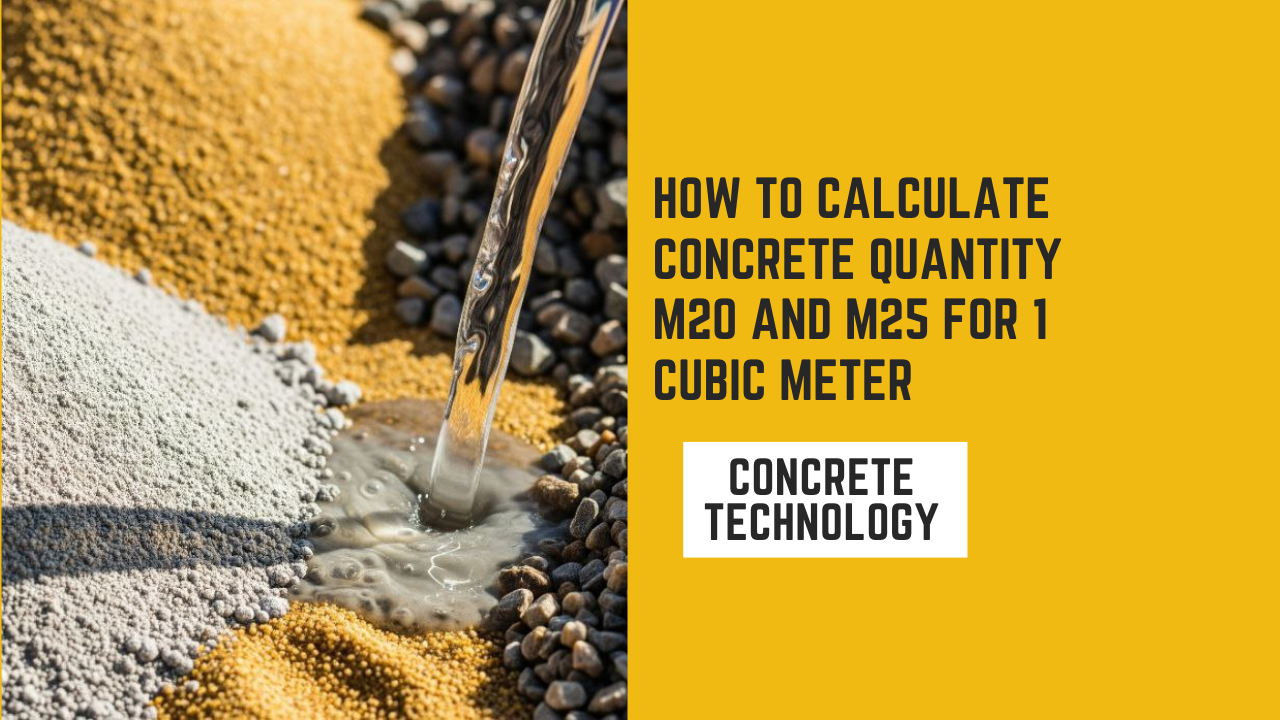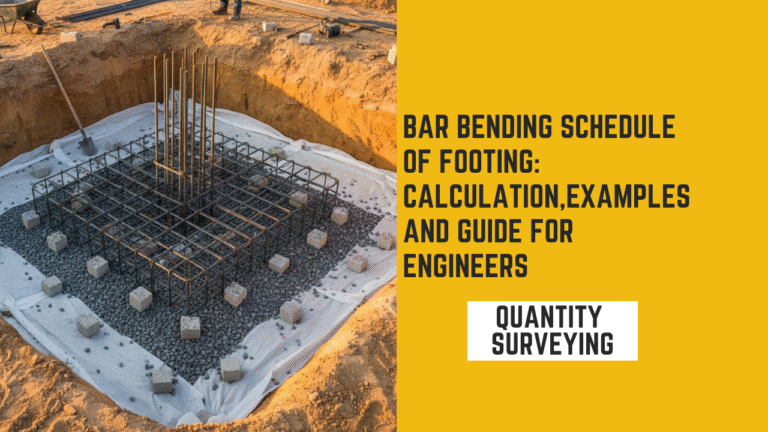How to calculate concrete quantity M20 and M25 for 1 cubic meter: A Complete Guide

Concrete is one of the most widely used materials in construction, forming the foundation, columns, beams, and columns of structures. Among the various grades, M20 and M25 are commonly used for residential buildings, commercial buildings, and infrastructure projects. Accurate calculation of concrete quantity M20 and M25 is essential for ensuring strength, durability, and cost-efficiency. This article provides a step-by-step guide on how to calculate the quantity of M20 and M25 concrete required for 1 cubic meter (1 m³) of concrete
Understanding Concrete Grades
Concrete grades indicate the compressive strength of concrete after 28 days of curing.
- M20 concrete: this grade has a characteristic strength of 20 Mpa.It is typically used for non-structural elements such as pavements, footings, and small residential slabs.
- M25 concrete: with a characteristic strength of 25 MPa, M25 concrete is suitable for structural components including beams, columns, slabs and foundations
The difference in strength comes from the proportion of cement, sand, aggregates and in the mix.
Concrete mix ratios
The mix ratio represents the relative proportion of cement, sand, and aggregates.
M20 mix ratio 1: 1.5 : 3
- Cement: 1 part
- Sand: 1.5 parts
- Aggregates: 3 parts
M25 mix ratio: 1 : 1 : 2
- Cement: 1 part
- Sand: 1 parts
- Aggregates: 2 parts
These ratios ensure that the concrete achieves the required strength and workability for construction purposes
Calculate Material Quantities for M20 Concrete
Step 1: Calculate Dry Volume
Concrete loses volume due to shrinkage and compaction during mixing. Therefore, dry volume is used for material calculation:
Dry Volume = Wet Volume × 1.54
Since we are calculating for 1 m³ of concrete:
Dry Volume = 1 × 1.54 = 1.54 m³
This is the total volume to be divided among cement, sand, and aggregates according to the mix ratio.
Step 2: Calculate concrete Quantity for M20 Concrete
Cement Quantity
M20 mix ratio = 1 : 1.5 : 3
Total parts = 1 + 1.5 + 3 = 5.5
Cement Volume = (1 / 5.5) × Dry Volume
Cement Volume = (1 / 5.5) × 1.54 ≈ 0.28 m³
Weight of Cement = Cement Volume × 1440 kg/m³
Weight = 0.28 × 1440 ≈ 403.2 kg
Number of cement bags (50 kg per bag) = 403.2 ÷ 50 ≈ 8 bags
Sand Quantity
Sand proportion = 1.5 parts
Sand Volume = (1.5 / 5.5) × Dry Volume
Sand Volume = (1.5 / 5.5) × 1.54 ≈ 0.42 m³
Weight of sand = 0.42 × 1600 ≈ 672 kg
Coarse Aggregate Quantity
Coarse aggregate proportion = 3 parts
Aggregate Volume = (3 / 5.5) × Dry Volume
Aggregate Volume = (3 / 5.5) × 1.54 ≈ 0.84 m³
Weight of aggregates = 0.84 × 1450 ≈ 1218 kg
Water Requirement
Water-cement ratio for M20 ≈ 0.5
Water required = 403.2 × 0.5 ≈ 201.6 liters
Adding the right amount of water ensures proper hydration and workability.
Calculate Material Quantities for M25 Concrete
Step 1: Calculate Dry Volume
Concrete loses volume due to shrinkage and compaction during mixing. Therefore, dry volume is used for material calculation:
Dry Volume = Wet Volume × 1.54
Since we are calculating for 1 m³ of concrete:
Dry Volume = 1 × 1.54 = 1.54 m³
This is the total volume to be divided among cement, sand, and aggregates according to the mix ratio.
Step 2: Calculate Material Quantities for M20 Concrete
Cement Quantity
M25 mix ratio = 1 : 1 : 2
Total parts = 1 + 1 + 2 = 4
Cement Volume = (1 / 4) × Dry Volume
Cement Volume = (1/4)*1.54 ≈ 0.385 m³
Weight of cement = 0.385 × 1440 ≈ 554.4 kg
Number of cement bags = 554.4 ÷ 50 ≈ 11 bags
Sand Quantity
Sand proportion = 1 part
Sand Volume = (1 / 4) × Dry Volume ≈ 0.385 m³
Weight of sand = 0.385 × 1600 ≈ 616 kg
Coarse Aggregate Quantity
Coarse aggregate proportion = 2 parts
Aggregate Volume = (2 / 4) × Dry Volume ≈ 0.77 m³
Weight of aggregates = 0.77 × 1450 ≈ 1116.5 kg
Water Requirement
Water-cement ratio for M25 ≈ 0.45
Water required = 554.4 × 0.45 ≈ 249.5 liters
Water ensures proper hydration and workability while maintaining the concrete strength.
Tips for Accurate Calculation
- Check Moisture Content in Sand: Adjust for moisture to maintain the correct water-cement ratio
- Use clean aggregates:Contaminants can reduce concrete strength
- Mix Properly: Ensure uniform mixing, either manually or with a concrete mixer
- Curing: Proper curing for 28 days is essential for achieving desired strength
- Allowance for Wastage: Include 2-5 % extra material for spillage and wastage
Practical Applications
- M20 Concrete: Footings, pavements, flooring, small residential slabs, and low-strength structural members
- M25 concrete: beams, columns, slabs, foundations, and load-bearing structural elements.
Choosing the correct grade ensures that structures are safe, durable and cost-effective
This table allows quick reference for small-scale construction projects.
Scaling for larger projects
For larger projects, multiply the material quantities by the required volume. For
For example, if a project requires 10 m³ of M25 concrete
- Cement: 11 bags × 10 = 110 bags
- Sand: 616 × 10 = 6160 kg
- Aggregates: 1116.5 × 10 = 11,165 kg
- Water: 249.5 × 10 = 2495 liters
Accurate scaling ensures proper resource planning and cost estimation.
Common Mistakes to Avoid
- Incorrect Mix Ratios: Using wrong proportions can compromise strength
- Ignoring Dry Volume: Leads to insufficient concrete
- Overwatering: Reduces strength and increases shrinkage
- Skipping Curing: Affects durability and compressive strength
- Neglecting Material Quality: Low-quality cement or aggregates reduce structural integrity
Conclusion
Calculating the cost The quantity of M20 and M25 concrete for 1 cubic meter requires understanding the mix ratios, dry volume, and proportion of cement used. By following the steps outlined above, you can accurately determine the required quantities of cement, sand, aggregates, and water. proper planning, mixing and curing will ensure durable, strong and cost-effective concrete for any construction project
Accurate material calculation saves money, reduces wastage and ensures structural safety, making it an essential skill for engineers, contractors and builders
This step-by-step guide provides all the necessary information to calculate M20 and M25 concrete for 1 cubic meter. Making it a practical resource for construction professionals and DIY enthusiasts alike






